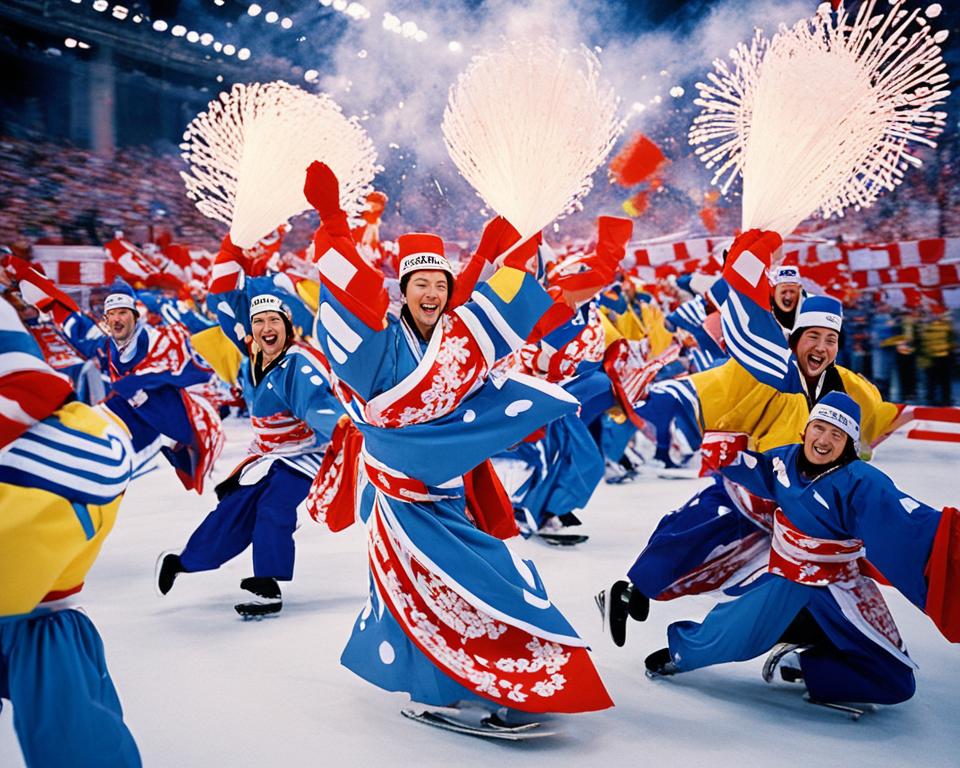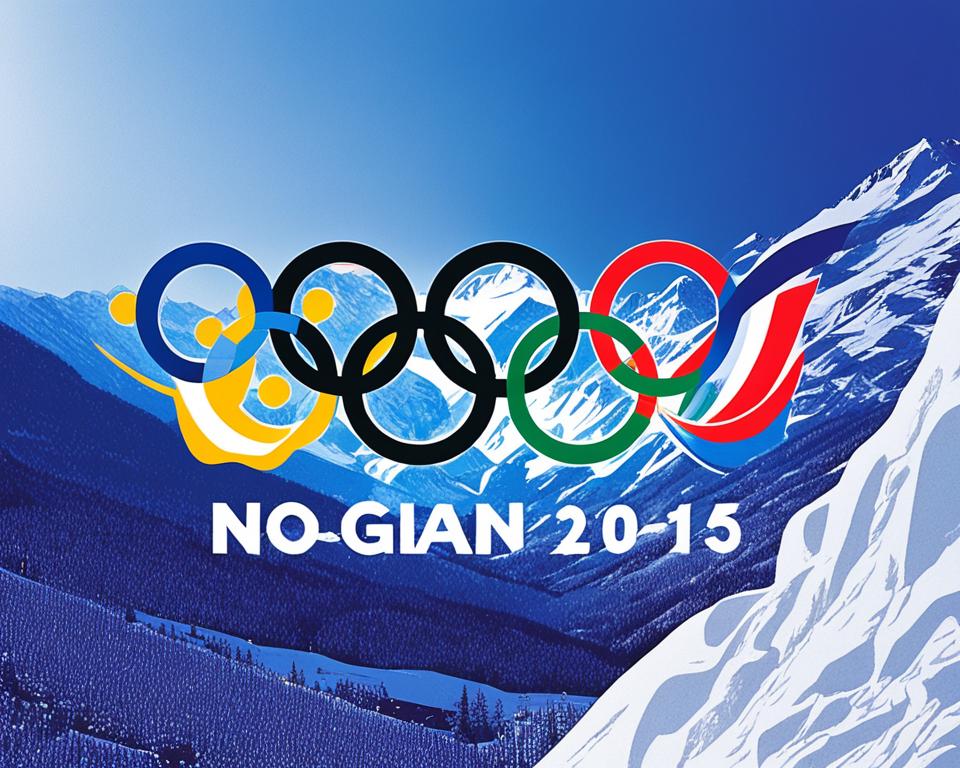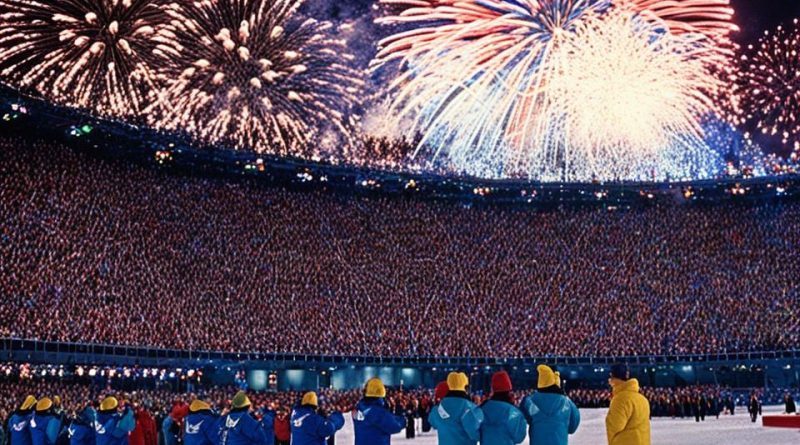1998 Winter Olympics Site: Nagano, Japan
The 1998 Winter Olympics were a groundbreaking event, marking the first time the Winter Games were hosted in Asia. Nagano, Japan, was chosen as the site. It showed the country’s skill in organizing and running a big international event. This article will look into the captivating history, detailed preparations, and lasting impact of the 1998 Winter Olympics in Nagano.
It will highlight the iconic venues, exciting winter sports events, and unforgettable moments. These made the Games truly special.
Read more interesting information at ::cosblog
Nagano: The Winter Olympics Host City
Nestled in the Japanese Alps, Nagano was a perfect choice for the 1998 Winter Olympics. Its mountains and snow made it ideal for winter sports. The city’s geography and climate were perfect for the Games.
Geographical Location and Climate
Nagano sits high, at 1,412 meters above sea level. Its terrain and snowfall were great for the Winter Games. Being close to mountains and a winter sports hub, Nagano had the needed facilities ready.
Historical Significance of Nagano
Nagano also has a rich culture, making it a great Olympic host. It’s the capital of Nagano Prefecture and has historic sites like the Zenkoji Temple from the 7th century. Its beauty and traditions made the 1998 Winter Olympics special.
| Nagano, Japan | Olympic Host City |
|---|---|
| Elevation | 1,412 meters (4,636 feet) |
| Average Snowfall | Abundant, ideal for winter sports |
| Cultural Landmarks | Zenkoji Temple (7th century) |
“Nagano’s stunning natural beauty and deep-rooted traditions made it a unique and captivating host for the 1998 Winter Olympics.”
The Bidding Process and Selection
The race to host the 1998 Winter Olympics was intense. Several cities wanted the honor. Nagano, Japan, won after a detailed check by the International Olympic Committee (IOC). Their strong bid and Japan’s promise to the Winter Games made Nagano the host.
The IOC looked at many things to pick the best city. They checked on infrastructure, transport, places to stay, and if the city could host a great event. Nagano’s careful planning and love for winter sports helped them win.
- Nagano’s bid showed their strong will and readiness.
- The host city selection was a detailed process by the olympic committee decision-makers.
- Japan’s dedication to the Winter Games and Nagano’s full plan were key to getting the 1998 Olympics.
The 1998 Winter Olympics in Nagano was a big win for the city and Japan. The successful 1998 winter olympics bidding and Nagano’s choice as host set the stage for a memorable event. It was a time of winter sports and cultural sharing.
Preparing for the 1998 Winter Olympics
Nagano was getting ready to host the 1998 Winter Olympics. The city changed a lot before the games. It worked on building new infrastructure and venues for athletes, officials, and fans.
Infrastructure Upgrades
Nagano improved its transport by adding highways, railways, and airports. This made moving people and goods easier. The city also made sure its communication and energy systems were ready for the big event.
Venue Construction
Nagano built new sports facilities for the Winter Olympics. This included ski jumping hills and ice skating rinks. The planning and building of these venues made sure the city could host top-level events.
The 1998 winter olympics preparations showed Nagano’s dedication to a great event. The infrastructure upgrades and venue construction made the city ready for the Olympics.
“Nagano’s transformation in the years leading up to the 1998 Winter Olympics was a remarkable feat of planning and execution. The city’s commitment to providing world-class facilities and infrastructure was evident in every aspect of the preparations.”
Winter Sports Events at the 1998 Olympics
The 1998 Winter Olympics in Nagano, Japan, were full of excitement. They featured thrilling events in alpine skiing and cross-country skiing. These events showed off amazing skills and athleticism.
Alpine Skiing
Alpine skiing was a big deal at the Nagano Olympics. Athletes from all over the world came to the famous Hakuba Ski Jumping Stadium. They competed in downhill, slalom, and giant slalom events.
The slopes were breathtaking, and the athletes were incredibly fast and precise. Their performances left everyone in awe.
Cross-Country Skiing
Cross-country skiing was just as exciting. It took place at the Nozawa Onsen Snow Resort. Athletes showed off their endurance and technique in long-distance races.
They glided across the snow-covered tracks with ease. The audience saw pure athletic excellence. Athletes gave their all to win Olympic glory.
The 1998 Winter Olympics in Nagano were a treat for winter sports fans. Alpine skiing and cross-country skiing were the stars. These events thrilled the crowd and showed off the athletes’ amazing skills and hard work.
“The 1998 Winter Olympics in Nagano was a true celebration of winter sports, where the world’s best athletes came together to push the limits of human performance.”
The Olympic Torch Relay
As the 1998 Winter Olympics in Nagano, Japan, approached, the country buzzed with excitement. The Olympic Torch Relay was a big deal, featuring a journey across Japan. Torch bearers, a mix of people, carried the flame, building excitement for the games.
The Olympic Flame started in Olympia, Greece, the Olympic Games’ birthplace. It then traveled to Japan, passing from torchbearer to torchbearer over thousands of miles. It went through all 47 prefectures before ending at the Olympic Stadium in Nagano.
Along the way, crowds cheered the torch bearers. The relay celebrated Japan’s culture, history, and unity. People from all walks of life came out to see this special event.
The Olympic Torch Relay ended with the lighting of the Olympic cauldron at the opening ceremony. This marked the flame’s end and the start of the 1998 Winter Games. It was the start of a global event that would amaze everyone.
The Iconic Opening and Closing Ceremonies
The 1998 Winter Olympics in Nagano, Japan, had two standout events. The opening and closing ceremonies wowed people all over the world. They highlighted Japan’s deep cultural roots, making the Olympics unforgettable.
Cultural Highlights
The opening ceremony celebrated Japanese culture with amazing music, dance, and theater. It showed off traditional Taiko drumming and Noh theater. This brought the audience into Japan’s long history of art.
The closing ceremony was just as stunning. It featured J-pop music, anime-style visuals, and J-dance. These showed Japan’s modern creativity and its big impact on the world.
These ceremonies were not just fun to watch. They showed Nagano’s promise to give us a memorable 1998 winter olympics opening and closing ceremonies. They celebrated Japan’s unique culture and its skill in hosting an olympic spectacle.

“The 1998 Winter Olympics in Nagano were a true testament to Japan’s cultural prowess, with the opening and closing ceremonies leaving a lasting impression on all who witnessed them.”
1998 Winter Olympics Site: Memorable Moments
The 1998 Winter Olympics in Nagano left a lasting mark on history. They brought us unforgettable moments that amazed the world. From amazing athletic feats to touching displays of sportsmanship, these events have become a big part of the Nagano Games’ legacy.
One standout moment was Tara Lipinski’s performance in figure skating. At just 15, she wowed everyone with her perfect routine. She became the youngest Olympic gold medalist in figure skating history. Her skill, hard work, and determination inspired both athletes and fans.
“Tara’s performance was a true testament to the power of the Olympic spirit. She showed that age is just a number when you have the talent and drive to achieve greatness.”
Bjørn Dæhlie, a Norwegian cross-country skier, had another unforgettable moment. He won four gold medals, proving he’s one of the best Winter Olympians ever. His amazing achievements amazed everyone and raised the bar for excellence in his sport.
- The dramatic showdown between American speedskater Dan Jansen and his long-time rival, Aleksandr Zhirov of Russia, which culminated in a thrilling photo finish.
- The emotional triumph of Canadian figure skater Elvis Stojko, who overcome a severe injury to claim the silver medal.
- The awe-inspiring ski jump performances of Finnish legend Matti Nykänen, who soared to new heights and solidified his legacy as one of the sport’s all-time greats.
The 1998 Winter Olympics in Nagano were unforgettable, filled with moments that will always be remembered. These achievements and stories inspire athletes and fans to this day.
Olympic Athletes and Medal Winners
The 1998 Winter Olympics in Nagano, Japan, celebrated athletes who made history. They inspired fans worldwide with their hard work and amazing skills.
Trailblazers and Record-Breakers
At the 1998 Nagano Olympics, some athletes changed their sports forever. 1998 winter olympics athletes like Picabo Street and Hermann Maier changed alpine skiing. They made incredible runs and won medal winners medals.
In cross-country skiing, Olympic champions Bjørn Dæhlie and Stefania Belmondo amazed everyone. They broke records and became legends.
| Athlete | Event | Medal |
|---|---|---|
| Picabo Street | Alpine Skiing | Gold |
| Hermann Maier | Alpine Skiing | Gold (2) |
| Bjørn Dæhlie | Cross-Country Skiing | Gold (3), Silver |
| Stefania Belmondo | Cross-Country Skiing | Gold, Silver (2) |
“The Olympic Games are the ultimate test of a champion’s mettle, and the athletes who shone at the 1998 Nagano Olympics truly embodied the spirit of the Games.”
Their records and achievements inspire today’s 1998 winter olympics athletes. They aim to be as great and make a lasting impact on winter sports.
The Impact of the 1998 Winter Olympics
The 1998 Winter Olympics in Nagano made a big change in the host city and area. It brought global attention, investments, and better infrastructure. Nagano became a top spot for winter sports and tourism.
Legacy and Lasting Impressions
The 1998 Games left a lasting mark. The Olympic venues are still used and maintained, hosting international sports events. Nagano is now known as a top spot for winter sports, drawing people from all over the world.
Nagano changed a lot because of the Olympics. It improved its infrastructure, transportation, and facilities. This helped the local community and made Nagano a top winter tourism and sports spot.

“The 1998 Winter Olympics in Nagano left an indelible mark on the region, inspiring generations of athletes and spectators alike.”
The 1998 Winter Olympics still affect Nagano today. The city’s Olympic legacy shows how hosting a big event can change a place. Nagano’s lasting changes have made it a top winter sports spot, promising a lasting impact.
Exploring the Olympic Venues Today
Many of the iconic venues from the 1998 Winter Olympics in Nagano, Japan, are still used today. They let visitors from all over the world see the 1998 winter olympics venues and nagano olympic facilities. It’s a chance to dive into the city’s Olympic history and feel the excitement of the 1998 Games.
The Hakuba Ski Jumping Stadium is a key spot, hosting ski jumping events for locals and visitors. The M-Wave, a long-track speed skating arena, is also active, welcoming skaters from everywhere. Nozawa Onsen Snow Resort is another spot where you can ski like Olympic athletes did before.
“Exploring these Olympic sites is like taking a step back in time, where the energy and excitement of the 1998 Games can still be felt,” said local tour guide, Akiko Tanaka. “It’s a truly unique opportunity to connect with Nagano’s rich sporting heritage.”
If you love sports or just want to learn about the 1998 Winter Olympics, Nagano’s venues are a must-see. They show the city’s history and its lasting role in winter sports.
- Explore the iconic Hakuba Ski Jumping Stadium, which continues to host international competitions.
- Experience the thrill of the slopes at the Nozawa Onsen Snow Resort, a former Olympic venue.
- Visit the M-Wave, the long-track speed skating arena, and witness the legacy of the 1998 Games.
1998 Winter Olympics Site: A Look Back
The 1998 Winter Olympics in Nagano have become a key part of Olympic history. They showed the city’s strength, flexibility, and dedication to the Olympics. This look back highlights the city’s lasting legacy.
The Nagano Games were a big deal, showing Japan’s skill in hosting a top-notch event. Nagano’s careful planning and new ideas set a high bar for future Olympics. The city’s venues and transport were top-notch, making the Games unforgettable.
The 1998 Winter Olympics also made a big impact on Nagano’s people. They felt proud and united, welcoming the Games with open hearts. The event let the world see Japan’s culture and history.
The legacy of the 1998 Winter Olympics in Nagano lives on. The sports facilities are now used for sports and community activities. The Games brought more tourists and helped make Nagano a top spot for winter sports fans.
The 1998 Winter Olympics are now history, but Nagano remains a great Olympic host. The Nagano Games show how the Olympics can inspire, bring people together, and change communities worldwide.
| Key Highlights of the 1998 Winter Olympics in Nagano |
|---|
|
The Evolution of the Winter Olympics
The 1998 Winter Olympics in Nagano was a big step for the Winter Games. It was the first time the Olympics were held in Asia. This event showed how the Olympics were becoming more global and diverse.
Since then, the Winter Olympics have changed a lot. They’ve added new sports, welcomed more cities, and improved how they’re run. This makes the event better for athletes and fans.
The 1998 Winter Olympics in Nagano was a key moment in this change. It helped make the Olympics more exciting and open to everyone. With new events and host cities, the Olympics keep changing to meet the needs of athletes and fans.
The legacy of the 1998 Nagano Games shows how the Olympics can grow and adapt. By bringing in new cultures and sports, the Olympics have become a worldwide celebration. They honor athletic achievement and the spirit of human competition.
